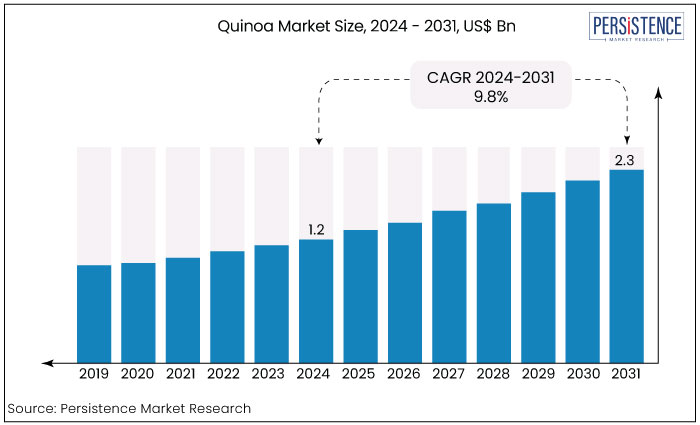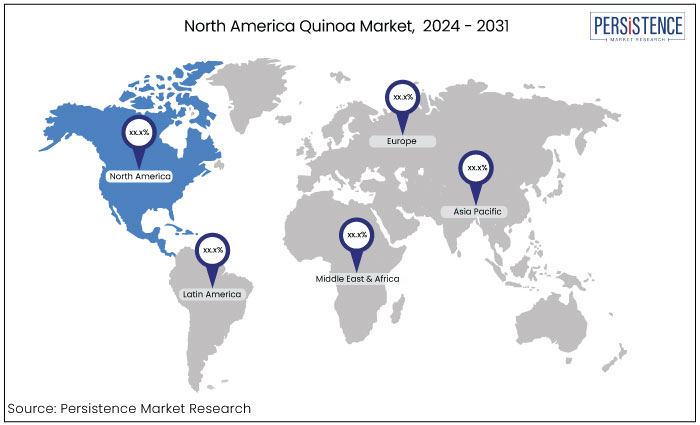Industry: Food and Beverages
Published Date: September-2024
Format: PPT*, PDF, EXCEL
Delivery Timelines: Contact Sales
Number of Pages: 166
Report ID: PMRREP34798
The quinoa market is estimated to reach a valuation of US$2.3 Bn by 2031 from the value US$1.2 recorded in 2024. The market is estimated to secure a CAGR of 9.8% during the forecast period from 2024 to 2031. The rising fascination with natural and organic products within the cosmetic industry is set to boost the global quinoa market significantly. Additionally, the growing incorporation of quinoa into breakfast foods is expected to drive substantial growth in the quinoa market throughout the forecast period.

Key Highlights of the Market
|
Attributes |
Key Insights |
|
Market Size (2024E) |
US$1.2 Bn |
|
Projected Market Value (2031F) |
US$ 2.3 Bn |
|
Global Market Growth Rate (CAGR 2024 to 2031) |
9.8% |
|
Historical Market Growth Rate (CAGR 2019 to 2023) |
8.2% |
North America is poised to lead the quinoa market, propelled by a rising focus on health and a shift towards premium food options. As health awareness grows and consumers seek out high-quality, nutritious foods, quinoa is gaining significant traction across developed countries in the region. This surge in popularity underscores a broader commitment to adopting healthier eating habits and making more informed dietary choices.
Premium food options often emphasize health and nutrition. Quinoa, known for its high protein content, essential amino acids, and other nutrients, aligns well with these demands. As consumers become more health-conscious, they are more likely to choose quinoa over less nutritious alternative.
The broad health and wellness movement in North America emphasizes the importance of high-quality ingredients. Quinoa’s reputation for supporting a balanced diet and promoting overall well-being resonates with consumers who are willing to pay more for foods that contribute to their health goals.

The industry is categorized into organic and inorganic segments, with consumer preferences shifting towards organic products due to health consciousness. Nowadays, people are more concerned about their consumption patterns and are actively seeking nutritious options. This change in consumer behavior has led to the increased popularity of organic quinoa driving the market growth.
The forecast period anticipates a significant surge in demand for organic products, which, in turn, will contribute to the overall growth of the quinoa market revenue globally. The rising demand for organic quinoa highlights the market's potential for expansion and diversification.
The market is categorized into food, cosmetic, and pharmaceutical industries based on application. Chefs globally are opting for quinoa as a replacement for rice due to its high protein, fiber, and zinc content and its gluten-free nature. Health-conscious consumers fuel this shift in culinary preferences, consequently driving the growth of the food industry.
The cosmetic industry utilizes quinoa for various purposes, such as reducing pigmentation, anti-aging treatments, and dandruff management. Quinoa's versatile applications across industries contribute to its expanding market presence and potential for future growth.
The market experienced significant growth in recent years driven by increasing consumer demand for healthy and nutritious food options. Quinoa, a grain-like crop known for its high protein content and gluten-free properties has become a versatile ingredient in various cuisines globally.
Consumers are increasingly seeking organic and sustainably sourced food products. The organic quinoa industry is expected to grow significantly driven by the rising preference for chemical-free and environment-friendly agricultural practices. Quinoa's versatility as an ingredient has contributed to its growing popularity in the food industry.
Growing awareness about quinoa's health benefits has fueled its demand among health-conscious consumers. All these quinoa market trends are expected to continue their growth trajectory in the coming years.
The quinoa industry has witnessed significant growth in recent years and is expected to continue its upward trajectory in the coming years. According to the provided data, the quinoa industry experienced substantial growth between 2019 and 2023. The market for quinoa recorded a CAGR of 8.2% during the period from 2019 to 2023.
The market is expected to maintain its growth momentum. The market is estimated to secure a CAGR of 9.8% from 2024 to 2031. The market is expanding its applications beyond being a staple food with increasing demand for quinoa in products such as breakfast cereals, snacks, bakery products, and beverages. The organic quinoa market is also expected to grow driven by the rising preference for chemical-free and environment-friendly agricultural practices.
Increasing Consumer Demand
The growing consumer demand for healthy and nutritious food options is driving the quinoa market growth. Quinoa is known for its nutritional characteristics and health benefits including high protein content, essential amino acids, and dietary fiber. As consumers become health-conscious, the demand for quinoa as a nutritious alternative to traditional grains is rising.
With rising awareness about various dietary trends and health conditions such as gluten intolerance, celiac disease, and metabolic disorders, quinoa has gained traction. It is naturally gluten-free making it a valuable alternative for people with gluten sensitivities or those seeking to avoid gluten.
The broad movement toward whole and minimally processed foods has bolstered quinoa’s popularity. Consumers are seeking out foods that are less processed and more aligned with natural dietary practices. Quinoa fits well within this movement due to its whole-grain status and its minimal processing requirements.
Expanding Applications in Food Products
Quinoa is not only a staple food but also finds applications in various food products such as breakfast cereals, snacks, bakery products, and beverages. The versatility of quinoa as an ingredient has contributed to its growing popularity in the food industry. The increasing use of quinoa in different food products is driving the market further.
Quinoa is being incorporated into a wide range of processed and packaged foods, from breakfast cereals and snack bars to pasta and baked goods. This diversification helps meet the needs of consumers looking for healthy, convenient food options and introduces quinoa to people who might not cook with it in its raw form.
The trend toward functional foods those that offer additional health benefits beyond basic nutrition includes quinoa due to its high fiber, protein, and nutrient content. It is being included in functional beverages such as smoothies and health drinks enhancing its appeal as a superfood.
Limited Variety Cultivation
The market growth is restricted due to the limited cultivation of certain quinoa varieties. Research suggests that a significant portion of quinoa production comes from only a few commercially viable types or cultivars out of the many varieties available. This limited variety of cultivation can hinder the market's potential for diversification and may restrict the availability of different quinoa types.
A lack of variety can reduce the appeal of quinoa to consumers who seek diverse options. For instance, different varieties may have distinct flavors, textures, or nutritional profiles. Limited variety could therefore restrict consumer choice and potentially limit market expansion.
Different quinoa varieties may be suited to different climates and soil conditions. Cultivating a limited range may restrict the geographical areas where quinoa can be effectively grown, limiting overall production capacity and market reach.
Pressures on Quinoa Farmers
Quinoa-producing countries, such as Bolivia, face pressures from various sides. The rise in global demand for quinoa has led to an increase in production. Still, farmers must balance meeting international quinoa market needs while safeguarding traditional knowledge, preserving biodiversity, and meeting household needs. These pressures can challenge farmers to maintain sustainable practices, ensure fair trade, and address food security concerns.
Expansion of Quinoa-Based Products
The development and expansion of quinoa-based products presents a key opportunity for the market players. As consumer demand for healthy and plant-based food options continues to rise, there is a growing opportunity to innovate and create a wide range of quinoa-based products. This includes ready-to-eat meals, quinoa-based snacks, quinoa flour for baking, and quinoa-based beverages. Companies can tap into this expanding market segment by capitalizing on the versatility and nutritional benefits of quinoa.
Exploring New Regional Markets
The industry has grown in certain regions, but there are still untapped opportunities in other parts of the world. Exploring and expanding into new regional markets can open up avenues for increased consumption and market growth. For instance, Targeting Asian markets with a rising trend of health-conscious consumers and a growing demand for alternative grains can present significant quinoa market opportunities for its producers. By understanding these new markets' preferences and cultural contexts, companies can strategically position themselves for success.
The quinoa sector market is experiencing rapid growth characterized by its dynamic and thriving nature. The market report emphasizes this trend highlighting the vibrant opportunities within the sector.
Industry players are actively introducing new products and incorporating innovative technologies to capitalize on quinoa market opportunities. To enhance their market value, quinoa market companies are implementing key business strategies such as expanding their product portfolio, and optimizing supply chains for improved efficiency. These strategic approaches enable them to stay competitive and drive further growth in the quinoa market value.
Recent Developments in the Quinoa Market
|
Attributes |
Details |
|
Forecast Period |
2024 to 2031 |
|
Historical Data Available for |
2019 to 2023 |
|
Market Analysis |
US$ Billion for Value |
|
Key Regions Covered |
|
|
Key Market Segments Covered |
|
|
Key Companies Profiled |
|
|
Report Coverage |
|
|
Customization & Pricing |
Available upon request |
By Type
By Application
By Region
To know more about delivery timeline for this report Contact Sales

The market is predicted to rise from US$1.2 Bn in 2024 to US$ 2.3 Bn by 2031.
Rising preference for chemical-free and environment-friendly agricultural practices is propelling market growth.
A few of the leading market players are Fujitsu, Citrix Systems, Atos SE, and Fujitsu Limited.
Development and expansion of quinoa-based products provides a key opportunity for the market players.